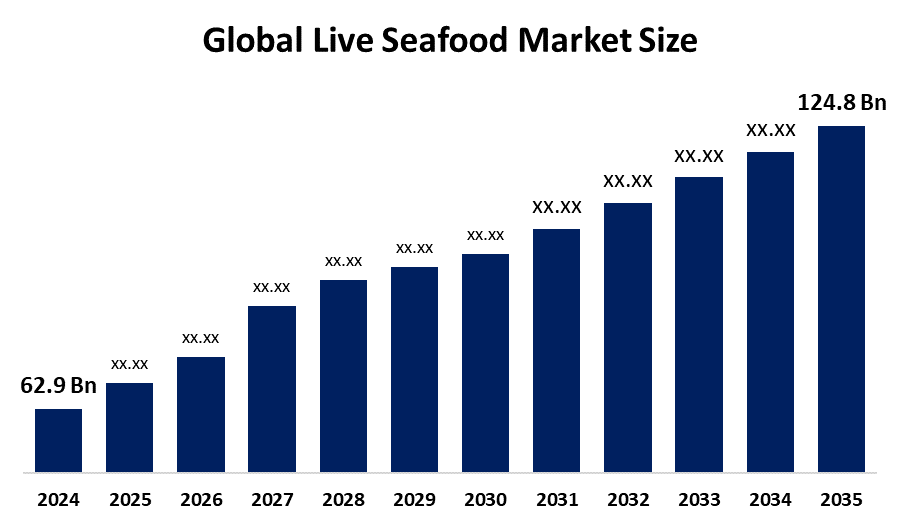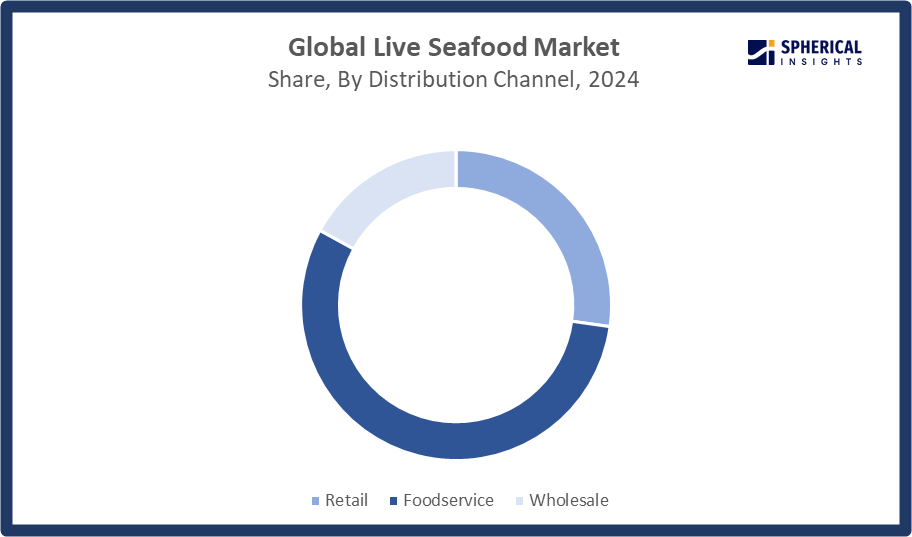Global Live Seafood Market Size, Share, and COVID-19 Impact Analysis, Russia-Ukraine War Impact, Tariff Analysis, By Product (Clams, Oysters, Crabs, Lobsters, and Others), By Distribution Channels (Retail, Foodservice, and Wholesale), and By Region (North America, Europe, Asia-Pacific, Latin America, Middle East, and Africa), Analysis and Forecast 2025 - 2035
Industry: Food & BeveragesLive Seafood Market Summary, Size & Emerging Trends
According to Spherical Insights, The Global Live Seafood Market Size is expected to grow from USD 62.9 Billion in 2024 to USD 124.8 Billion by 2035, at a CAGR of 6.43% during the forecast period 2025-2035. Growth in export markets, rising consumer demand for fresh products, technological developments in transportation and storage, rising seafood consumption, and increased industry profitability and innovation are all opportunities in the live seafood market.
Key Market Insights

Get more details on this report -
- Asia Pacific is expected to account for the largest share in the live seafood market during the forecast period.
- In terms of product, the lobsters segment is projected to lead the live seafood market in terms of equipment throughout the forecast period
- In terms of distribution channel, the foodservice segment captured the largest portion of the market
Global Market Forecast and Revenue Outlook
- 2024 Market Size: USD 62.9 Billion
- 2035 Projected Market Size: USD 124.8 Billion
- CAGR (2025-2035): 6.43%
- Asia Pacific: Largest market in 2024
- North America: Fastest growing market
Live Seafood Market
The term "live seafood market" describes a market within the larger seafood market that specializes in the distribution and sale of live aquatic animals, such as fish, crabs, mollusks, and other marine species. The live seafood market serves customers value authenticity, quality, and freshness, and frequently look for live fish for commercial, cultural, or culinary applications. The goal of the intricate supply chain, which includes harvesting, shipping, storing, and retail, is to keep the seafood viable and fresh until it is sold. Growing customer demand for fresh, premium seafood products that retain their flavor and nutritional content is fueling the live seafood market's continuous growth. The rising demand for live fish and shellfish, as well as the rising consumption of food labeled as sustainable and healthful, are driving the live seafood market.
Live Seafood Market Trends
- Growing Consumer Preference for Sustainable and Fresh Seafood: Due to its perceived freshness, nutritional content, and compatibility with environmentally friendly and sustainable food practices, consumers are placing a higher priority on live seafood.
- Technological Developments in Live Transport and Storage: The effectiveness and survival rates of live seafood throughout distribution are being improved by developments in aquaculture systems, cold chain logistics, and oxygenated transport tanks.
- Growth of Direct-to-Consumer and Internet Sales Channels: Direct access to live seafood is now possible due to e-commerce platforms and online marketplaces, which also help manufacturers reach new markets and give customers easy ways to buy premium goods.
- Increased Demand from High-End Hospitality and Culinary Sectors: To satisfy rising consumer demands for upscale, genuine eating experiences, fine dining establishments and upscale hotels are increasingly sourcing live seafood.
Global Live Seafood Market Report Coverage
| Report Coverage | Details |
|---|---|
| Base Year: | 2024 |
| Market Size in 2024: | USD 62.9 Billion |
| Forecast Period: | 2025-2035 |
| Forecast Period CAGR 2025-2035 : | 6.43% |
| 2035 Value Projection: | USD 124.8 Billion |
| Historical Data for: | 2020-2023 |
| No. of Pages: | 240 |
| Tables, Charts & Figures: | 124 |
| Segments covered: | By Product, By Distribution Channels and By Region |
| Companies covered:: | Mowi ASA, Thai Union, Pacific Seafood, Cooke Aquaculture, Nippon Suisan Kaisha, Dongwon Industries, Maruha Nichiro Corporation, Seajoy Seafood Corporation, Others. |
| Pitfalls & Challenges: | COVID-19 Empact, Challenges, Future, Growth, & Analysis |
Get more details on this report -
Live Seafood Market Dynamics
Driving Factors: Rising demand for fresh, healthy seafood options.
The increased demand for live fish and shellfish in the food service and retail industries, as well as consumers' preference for healthier, sustainable food options, are driving the live seafood market. One of the primary factors is the growing customer demand for fresh, premium, and nutrient-dense seafood, which is being driven by changing dietary habits and growing health consciousness. Market demand is driven by cultural and culinary traditions, especially in Asia and coastal countries, where live seafood is seen as a delicacy and a sign of freshness. Demand has also been driven by the expansion of the food service and hospitality industries, which include upscale dining establishments and lodging facilities.
Restrain Factors: Multiple constraints hinder live seafood growth.
Several constraints limit the live seafood market's ability to grow and operate efficiently. These include the high expenses of storage and shipping since maintaining the viability of seafood requires specific conditions and equipment. Furthermore, compliance is difficult due to strict regulations pertaining to food safety, environmental sustainability, and animal welfare. Market expansion and profitability in some areas are further hampered by limited shelf life, susceptibility to disease outbreaks, and logistical challenges.
Opportunity: Rising global demand fuels live seafood opportunities.
The growing demand for fresh, high-quality, protein-rich food around the world is driving incredible opportunities in the live seafood market. Customers are choosing live seafood products as a result of increased health consciousness and a preference for natural and sustainable food sources. Increased disposable incomes and growing urban populations, especially in emerging economies, are driving market expansion. Aquaculture, storage, and transportation technologies are improving product accessibility and decreasing losses. Furthermore, new opportunities for market penetration and worldwide reach are presented by the growth of international trade channels and online retail platforms.
Challenges: Disease, water quality, logistics hinder seafood supply.
Consistent supply and profitability are made difficult by disease outbreaks, variations in water quality, and constrained cold chain logistics in some areas. The necessity for expensive, specialized infrastructure is one of these, as is the high fatality rates during transportation brought on by stress and improper handling. Operations are made more complex by regulatory compliance about food safety, environmental impact, and animal welfare.
Global Live Seafood Market Ecosystem Analysis
The ecosystem of the global live seafood market includes a number of interrelated parties, such as aquaculture farms, distributors, merchants, fishermen, and end users. To preserve product viability and freshness, this ecosystem mostly depends on effective supply chains, cutting-edge transportation, and storage technology. In order to guarantee sustainable practices and adherence to food safety regulations, regulatory agencies and environmental groups are essential. Market stability is also supported by technology advancements in cold chain logistics, breeding, and disease prevention. These players' dynamic interactions influence market trends, create opportunities for development, and solve issues with sustainability and operational effectiveness.
Global Live Seafood Market, By Product
The lobsters segment led the live seafood market, generating the largest revenue share. Lobsters are a popular choice in the retail and food service industries worldwide due to their exceptional quality, flavor, and nutritional advantages. Due to their extensive availability through aquaculture and wild capture, as well as well-established supply systems that preserve product quality and freshness, lobsters are in high demand. Furthermore, lobsters' demand is further driven by their frequent association with upscale dining experiences.
The crabs segment in the live seafood market is expected to grow at the fastest CAGR over the forecast period. Growing customer interest in a variety of seafood options, growing knowledge of the health advantages of crab meat, and increased availability as a result of better aquaculture techniques are all factors contributing to the crab segment's rise.
Global Live Seafood Market, By Distribution Channel
The foodservice segment held the largest market share in the live seafood market. The enormous demand for fresh, premium seafood in eateries, lodging facilities, and catering services, especially in cities and popular tourist destinations, drives the foodservice segment. The foodservice is supported by the rise in upscale dining establishments and consumer preference for eating out.

Get more details on this report -
The retail segment in the live seafood market is projected to register the fastest CAGR. Growing consumer access to live seafood through supermarkets and specialized shops, the popularity of home cooking, and the growth of online seafood retail platforms contribute to the retail segment.
Asia Pacific is expected to account for the largest share of the live seafood market during the forecast period. The Asia-Pacific region benefits from a deeply ingrained cultural taste for live and fresh fish, especially in Southeast Asian countries, China, Japan, and South Korea, where seafood is a staple cuisine. The demand for premium, high-protein live seafood products is also being driven by consumer health consciousness, expanding urbanization, and rising disposable incomes. Additionally, government programs supporting export-oriented aquaculture and sustainable fishing methods boost the local economy.

Get more details on this report -
China is experiencing steady growth in the live seafood market. China's growing urbanization, rising disposable incomes, and growing consumer demand for fresh, premium seafood are its main drivers. The nation's growing live seafood business is further aided by government backing for sustainable fishing methods and technological developments in aquaculture.
North America is expected to grow at the fastest CAGR in the live seafood market during the forecast period. North America's rapid rise is mostly due to growing consumer demand for sustainable, high-quality, and fresh seafood items, as well as growing health consciousness. The demand for live seafood in restaurants and specialty market is rising as a result of the growing food service sector, especially in urban areas. Furthermore, improvements in transportation and cold chain logistics have increased the quantity and quality of live fish available throughout the region.
United States is the largest market for live seafood. The United States' vast foodservice sector, growing consumer inclination for sustainable and fresh fish, and sophisticated cold chain infrastructure all contribute to the country's strong demand for and distribution of live seafood products.
Competitive Analysis:
The report offers the appropriate analysis of the key organizations/companies involved within the live seafood market, along with a comparative evaluation primarily based on their type of offering, business overviews, geographic presence, enterprise strategies, segment market share, and SWOT analysis. The report also provides an elaborate analysis focusing on the current news and developments of the companies, which includes product development, innovations, joint ventures, partnerships, mergers & acquisitions, strategic alliances, and others. This allows for the evaluation of the overall competition within the market.
WORLDWIDE TOP KEY PLAYERS IN THE LIVE SEAFOOD MARKET INCLUDE
- Mowi ASA
- Thai Union
- Pacific Seafood
- Cooke Aquaculture
- Nippon Suisan Kaisha
- Dongwon Industries
- Maruha Nichiro Corporation
- Seajoy Seafood Corporation
- Others
Key Target Audience
- Market Players
- Investors
- End-users
- Government Authorities
- Consulting And Research Firm
- Venture capitalists
- Value-Added Resellers (VARs)
Product Launches in the Live Seafood
- In December 2024, the distribution of six freeze-dried food products produced by the Maruha Nichiro Corporation in Japan was announced by Sai Gon Food Joint Stock Company. Their strategy to gain market share in Vietnam included this. This is covered by the "MNV 2024" plan, which emphasizes global expansion. The business aims to increase its presence in Southeast Asia, particularly Vietnam, where the country's rapidly changing culinary culture and Maruho's economic expansion are setting the standard for evolution.
Market Segment
This study forecasts revenue at global, regional, and country levels from 2020 to 2035. Spherical Insights has segmented the live seafood market based on the below-mentioned segments:
Global Live Seafood Market, By Product
- Clams
- Oysters
- Crabs
- Lobsters
- Others
Global Live Seafood Market, By Distribution Channel
- Retail
- Foodservice
- Wholesale
Global Live Seafood Market, By Regional Analysis
- North America
- US
- Canada
- Mexico
- Europe
- Germany
- UK
- France
- Italy
- Spain
- Russia
- Rest of Europe
- Asia Pacific
- China
- Japan
- India
- South Korea
- Australia
- Rest of Asia Pacific
- South America
- Brazil
- Argentina
- Rest of South America
- Middle East & Africa
- UAE
- Saudi Arabia
- Qatar
- South Africa
- Rest of the Middle East & Africa
Frequently Asked Questions (FAQ)
-
1. What is the CAGR of the live seafood market over the forecast period?The global live seafood market is projected to expand at a CAGR of 6.43% during the forecast period.
-
2. What is the market size of the live seafood market?The global live seafood market Size is expected to grow from USD 62.9 billion in 2024 to USD 124.8 billion by 2035, at a CAGR of 6.43% during the forecast period 2025-2035.
-
3. Which region holds the largest share of the live seafood market?Asia Pacific is anticipated to hold the largest share of the live seafood market over the predicted timeframe.
-
4. Who are the top 10 companies operating in the global live seafood market?Key players include in Mowi ASA, Thai Union, Pacific Seafood, Cooke Aquaculture, Nippon Suisan Kaisha, Dongwon Industries, Maruha Nichiro Corporation, Seajoy Seafood Corporation, and Others.
-
5. What factors are driving the growth of the live seafood market?The growth of the live seafood market is driven by increasing consumer demand for fresh products, rising health awareness, expanding seafood consumption, advancements in supply chain logistics, and growth in coastal and urban populations.
-
6. What are the main challenges restricting wider adoption of the live seafood market?The main challenges restricting wider adoption of the live seafood market include high transportation costs, limited shelf life, stringent regulatory requirements, inadequate infrastructure, and the complexity of maintaining optimal live seafood quality during distribution.
Need help to buy this report?